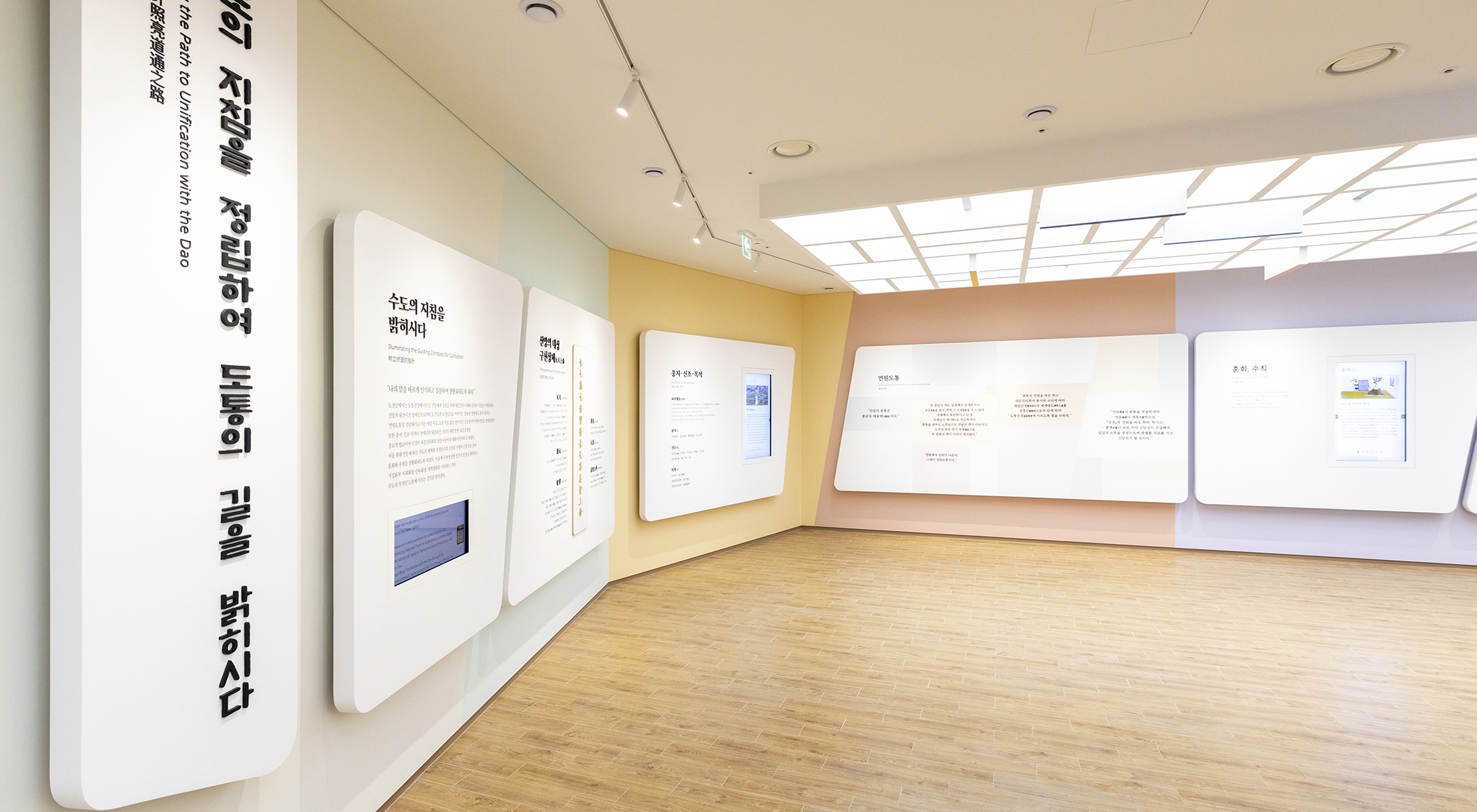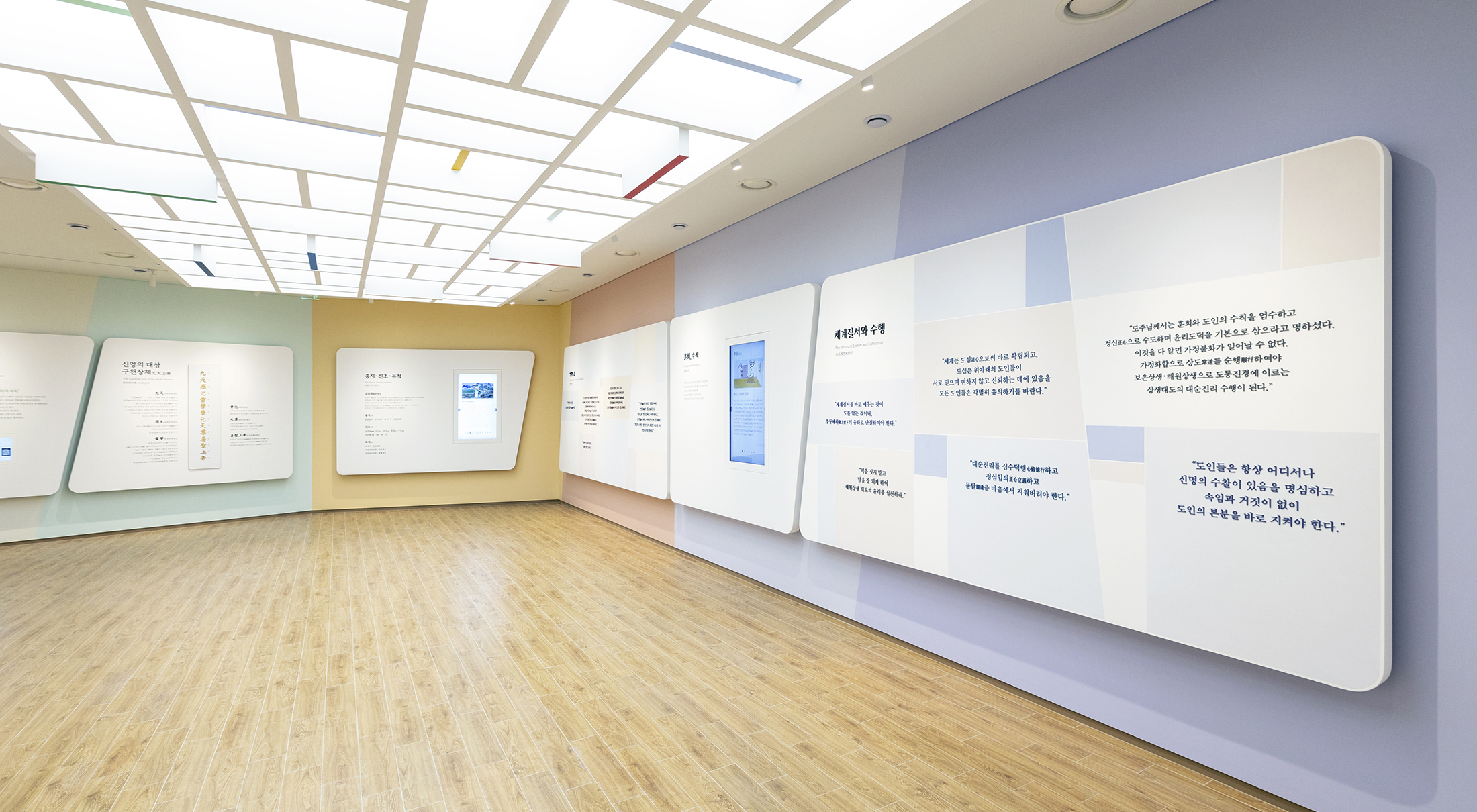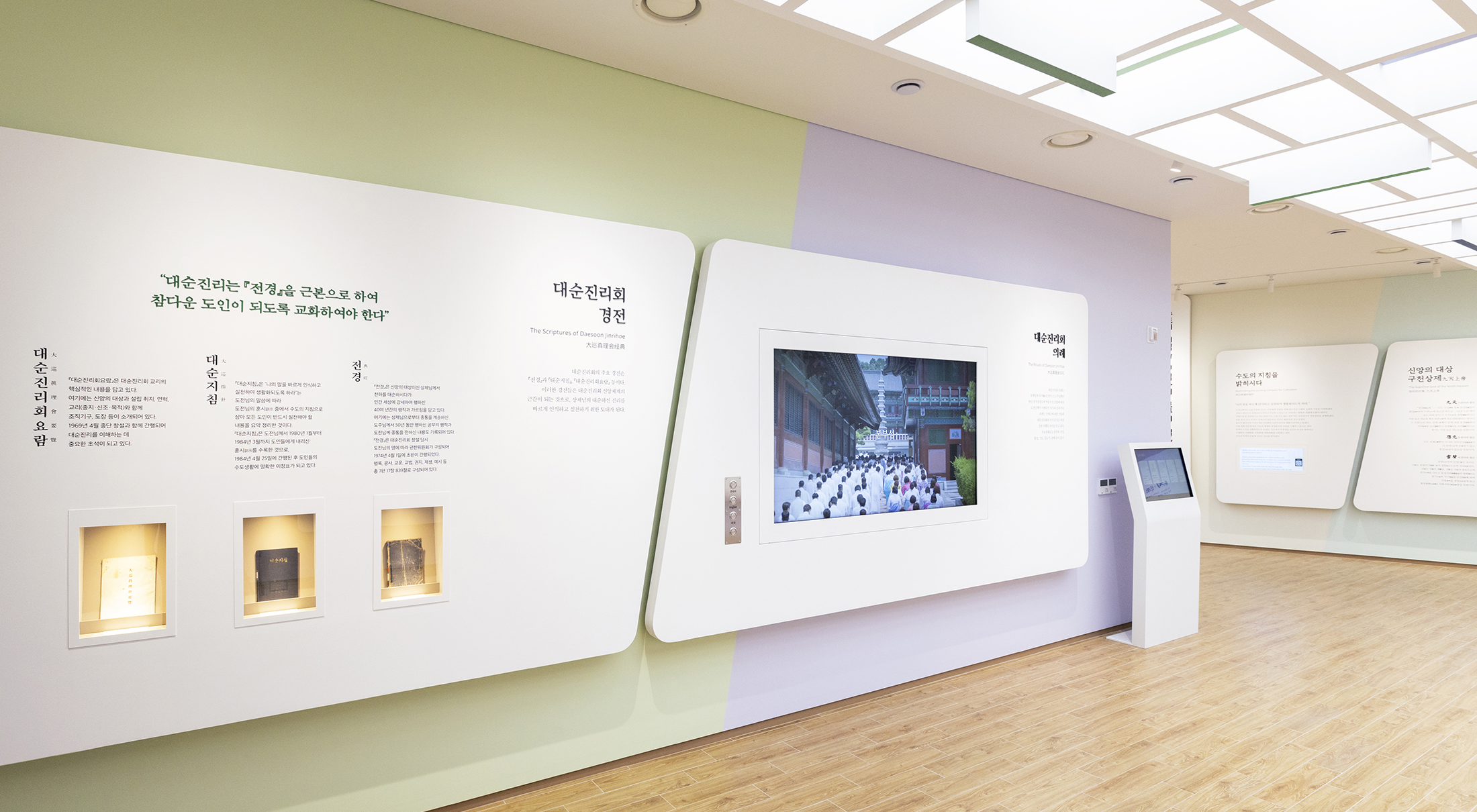Spreading Sangje’s Virtue
All over the World
- Illuminating the Guiding Compass
for Cultivation
“Make my words into a way of life by recognizing and practicing them rightly.”
Dojeon provided guidelines for understanding and practicing Daesoon Truth,
aiming to establish a faith system that leads to the ‘Perfected State of Unification with the Dao.’
Regarding ‘Unification with the Dao through the Fountainhead,’
Dojeon taught that this unification is attainable solely through the Orthodox Religious Lineage,
which comprises the three Holy Figures (the Fountainhead, ‘Yeonwon’).
The lineage begins with Sangje, the Object of Faith, extends to Doju, and then Dojeon.
Dojeon emphasized that this lineage is not a mere thing that can be changed or revised;
instead, it is a profound source of holiness bestowed directly by Heaven.
Additionally, Dojeon taught that the Tenets, Creeds, and Aims
represents the religious laws and dharmic logic underlying
the concepts of the ‘Resolution of Grievances for Mutual Beneficence’
and the ‘Grateful Reciprocation of Favors for Mutual Beneficence,’
which were revealed by Sangje through His Great Itineration.
These principles also embody both Daesoon Jinrihoe’s philosophy of Human Nobility and our philosophy of peace.
To fulfill this purpose, Dojeon emphasized the importance of maintaining our cultivation
within our unique organizational system,
which is bound by ‘Destined Human Relationships (Yeonwun)’ and by practicing the ethics of Mutual Beneficence.
Furthermore, he stressed the integration of the ‘Precepts’ and ‘Ethical Rules’ into our daily lives.
He revealed that by following these principles, humanity can attain a state of selfless purity
and attain familial harmony, social cohesion, peace among humankind, and peace throughout the world.
He concluded that this is the path that leads to the ultimate goal of our cultivation, ‘Unification with the Dao.’ - The Supreme God of the Ninth Heaven
Gucheon Eungwon Noeseong Bohwa Cheonjon Kangseong Sangje
(His Holiness the Supreme God Kang of the Ninth Heaven,
Celestial Worthy of Universal Creation through His Thunderbolt,
the Originator with Whom All Beings Resonate)
Gucheon (Ninth Heaven) is a name derived from the following scriptural passage:
“...all the divine sages, buddhas, and bodhisattvas, who had existed since the dawn of time,
gathered and petitioned Me in the Ninth Heaven...”
This means that they appealed to the highest Celestial Worthy,
the one who presides with supreme authority over the cosmos.
The Ninth Heaven is the highest location of all,
a post from which Sangje supervises the Three Realms, coordinates Heaven and Earth,
and directs the process of their unfolding.
Eungwon (Resonation with the Supreme) indicates
that none of the myriad forms dense or close, including heavenly bodies,
would be able to come into being without having the sympathetic resonance of a heavenly mandate.
Noeseong (Lightning and Thunder) symbolizes
the command of Heaven and voice of benevolence.
Lightning is created by the two vital forces of yin and yang.
Lightning is the essence (che 體) of thunder, and thunder is the function (yong 用) of lightning.
The thunderbolt divides Heaven from Earth.
The thunderbolt causes the energy of Heaven and Earth to ascend and descend
through the oscillation between movement and stillness, advance and retreat,
enables everything grow, and it controls the becoming and changing of everything in Creation.
Bohwa (Universal Creation) signifies that every being
in the universe owes its existence, whether via form or formlessness,
to the creative virtue of the Celestial Worthy.
Cheonjon (Celestial Worthy) indicates that Sangje is the holiest
and greatest deity throughout the Three Realms,
who universally creates every being through His thunderbolt throughout all directions in space and time.
Kangseong Sangje (His Holiness the Supreme God Kang)
is the honored name of the omniscient and omnipotent God.
He exercises authority over the Three Realms, presides
and directs the myriad forms dense and close throughout the universe,
and attentively watches over all the Heavens. - The Tenets, Creeds, and Aims
Doctrinal Overview
With the embodiments of Daesoon Truth, Virtuous Concordance of Yin and Yang,
Harmonious Union between Divine Beings and Human Beings,
the Resolution of Grievances for the Mutual Beneficence,
and the Perfected State of Unification with the Dao, as our tenets,
we, Daesoon Jinrihoe, have the essential attitudes of cultivation,
the three focal dharmas of sincerity, respectfulness, and faithfulness
and the two statutes of quieting the mind and quieting the body as the cardinal mottos of our practice.
We cherish the observance of ethical norms and consider guarding against self-deception as fundamental.
We shall disseminate Sangje’s Virtues throughout the world, save all creatures,
support the nation, comfort the people, and create an earthly paradise
through the renovation of human beings and the transformation of the human spirit.
The Tenets
Virtuous Concordance of Yin and Yang
Harmonious Union between Divine Beings and Human Beings
Resolution of Grievances for Mutual Beneficence
Perfected State of Unification with the Dao
The Creeds
The Four Cardinal Mottos: Quieting the Mind, Quieting the Body, Reverence for Heaven, Cultivation
The Three Essential Attitudes: Sincerity, Respectfulness, Faithfulness
The Aims
Guarding against self-deception / Re-creation of the inner-spirit
Realizing earthly immortality / Renovation of human beings
Creating an earthly paradise / Re-creation of the world
- Unification with the Dao
through the Fountainhead
“The Lineage of Religious Orthodoxy conveyed by the Fountainhead is the vital artery of our religious order.”
“The truth comes from the Fountainhead,
and thereby, Enlightenment in the Dao is achieved through the Fountainhead.”
“The artery of our religious order originates from Sangje’s descent into the world
and His subsequent unfolding of the ‘Progress of Our Order.’
After Sangje ascended to Heaven, Doju attained the Dao through a divine revelation from Sangje
and established the Lineage of Religious Orthodoxy.
This is how the artery of the Fountainhead formed.
Shortly before Doju’s passing into Heaven, he issued a deathbed edict
to ensure the continuous flow of the Fountainhead to his successor.”
“First and foremost, you must follow the Fountainhead (Yeonwon) in the Lineage of Religious Orthodoxy
and cultivate yourself through the Great Dao of Redeeming the World
by resolving grievances for Mutual Beneficence.
Adhere to the tenets and doctrines of Daesoon Jinrihoe
while striving to refine yourself with sincerity, respectfulness, and faithfulness.
By doing so, you will pave the way to reach the Perfected State of Unification with the Dao.”
“Destined Human Relationships (Yeonwun) can come to flourish
only when the Lineage of Religious Orthodoxy is firmly established
as they stem from the Fountainhead (Yeonwon).
Therefore, The Canonical Scripture instructs readers to ‘Follow the Fountainhead’...
Thus, maintaining the correct lineage of our religious order is essential for the soundness of our faith.
Only then can devotees become genuine believers,
whose hope to attain a singularly-focused mind can be achieved through their sincere devotion.” - The Precepts and Ethical Rules
“We should engage in self-reflection and personal growth
by following the Precepts and Ethical Rules while striving for personal edification.
You should strive to embody the mental virtues that promote generosity and kindness,
the verbal virtues that foster virtuous and respectful speech, and the physical virtues
that result in righteous conduct and behaviors.
Mastery of these virtues equips us to become sagacious cultivators of the Dao.” - The Structural System and Cultivation
“To establish the order of the structural system correctly is synonymous
with cultivating the Dao. You should unite with one another in harmony,
respecting your seniors and guiding your juniors.”
“The structural system is secured correctly through faith in the Dao.
Faith in the Dao relies on senior and junior Dao cohorts
trusting one another without deviation. Make sure to keep this in mind.”
“Practice the ethics of the Great Dao of the Resolution of Grievances
for Mutual Beneficence by refraining from provoking grudges (Cheok)
and promoting the betterment of others.”
“Based on Daesoon Truth, you should cultivate your minds,
practice virtue, align your minds with righteousness,
and remove the desire for reputation from your hearts.”
“Dao cohorts should always bear in mind that divine beings keep an eye on us everywhere.
Therefore, they should uphold their identity as Dao cohorts
and avoid falling into deception and falsehood.”
“Doju instructed Dao cohorts to adhere to the precepts and ethical rules,
cultivate with the right mindset, and uphold ethics and morality.
By understanding and embodying these principles, familial discord can always be prevented.
Only by following the constant Dao and maintaining familial harmony,
one can truly practice the Daesoon Truth of the Great Dao of Mutual Beneficence.
This practice ultimately leads to the Perfected State of Unification with the Dao
through the Grateful Reciprocation of Favors for Mutual Beneficence
and the Resolution of Grievances for Mutual Beneficence.”
- Unification with the Dao
is a Requital of the Beneficence
Endowed by Heaven and Earth
“The goal of Dao cultivation is the Unification with the Dao.”
“In the future, divine beings will bestow nobility upon humanity by residing within them.
As a result, humans and divine beings will achieve harmony,
known as Unification with the Dao or Enlightenment in the Dao.”
“The Unification with the Dao in that era will have its foundation in the Fountainhead (Yeonwon),
thus it is referred to as ‘Unification with the Dao via the Fountainhead.’”
“Unification with the Dao and a glorious destiny are attainable only when one guards against self-deception.”
“After polishing your mind like a mirror and restoring your essence
as a sincere and honest human, you will be able to attain Unification with the Dao.”
“Be mindful of the following: ‘If one’s mind is insincere,
then one’s intention will be insincere, and if one’s intention is insincere,
then insincerity will manifest physically. If insincerity manifests physically,
one will not achieve the Perfected State of Unification with the Dao.’”
- The Rituals of Daesoon Jinrihoe
The rites of Daesoon Jinrihoe encompass ceremonies and their corresponding procedures
performed by Dojeon in accordance with the true dharma revealed by Doju,
who embraced Sangje’s intention throughout his 50-Year Holy Work.
These rites hold the significance of fostering faith in Sangje
while also serving as a means to practice and achieve the purpose of Daesoon Jinrihoe.
The main rites include Holy Works, devotional offerings, monthly monetary offerings,
prayers, the initiation ceremony, and temple acclimation. - The Scriptures of Daesoon Jinrihoe
“Daesoon Jinrihoe should educate devotees to become true Dao cohorts
based on The Canonical Scripture.”
The main scriptures of Daesoon Jinrihoe are The Canonical Scripture,
The Guiding Compass of Daesoon, and Essentials of Daesoon Jinrihoe.
These scriptures serve as the backbone of the faith system in Daesoon Jinrihoe
and provide the foundation for recognizing and practicing Daesoon Truth of Sangje.
The Canonical Scripture (Jeon-gyeong)
The Canonical Scripture chronicles about 40 years of actions and teachings by Sangje,
our object of faith, after His descent into the world following His Great Itineration.
It also records the 50 years of Holy Works performed by Doju,
who succeeded Sangje in the Lineage of Religious Orthodoxy,
and the episode in which he passed the Lineage of Religious Orthodoxy onto Dojeon.
The Canonical Scripture was published on April 1, 1974 by a compilation committee
formed under the command of Dojeon when Daesoon Jinrihoe was founded.
It consists of a total of 7 sections, 17 chapters, and 839 verses covering Acts, Reordering Works,
Progress of the Order, Dharma, Authority and Foreknowledge, Saving Lives, and Prophetic Elucidations.
The Guiding Compass of Daesoon (Daesoon Jichim)
In keeping with Dojeon’s teaching, “Recognize my words properly, practice them, and apply them to your life,”
The Guiding Compass of Daesoon serves as a summary of essential practices
that all Dao cohorts must follow for their Dao cultivation.
It is a collection of teachings Dojeon sent to Dao cohorts from January 1980 to March 1984.
Since its first publication on April 25, 1984, it has been a significant milestone in the spiritual lives of Dao cohorts.
Essentials of Daesoon Jinrihoe (Daesoon Jinrihoe Yoram)
Essentials of Daesoon Jinrihoe contains the core content of the doctrines
of Daesoon Jinrihoe. It includes the object of faith and the founding motive,
the history, and the doctrines (tenets, creeds, and aims), along with organizational structures and temple complexes.
It was published concurrently with the founding of Daesoon Jinrihoe in April 1969
and has since become a significant cornerstone for comprehending Daesoon Truth.
Spreading Sangje’s Virtue
All over the World

1Dojeon’s Descent and Birth

2Being Promoted as a Representative in Taegeukdo
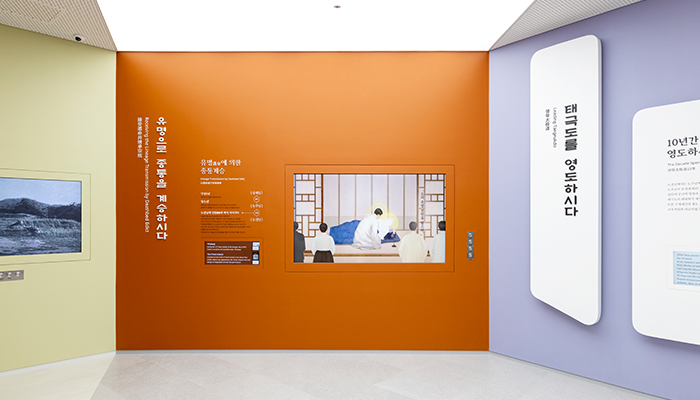
3Receiving the Lineage Transmission by Deathbed Edict

4Leading Taegeukdo
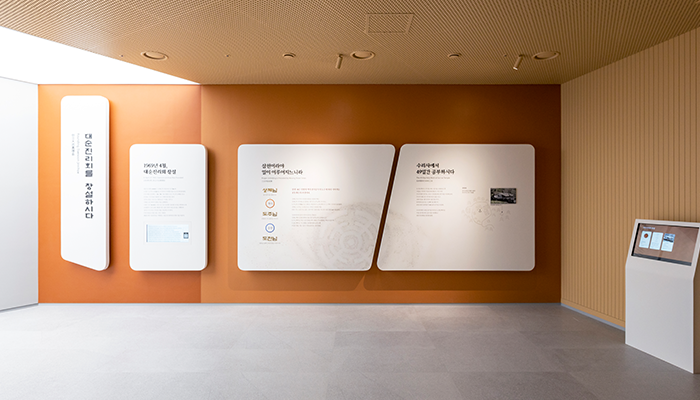
5Founding Daesoon Jinrihoe
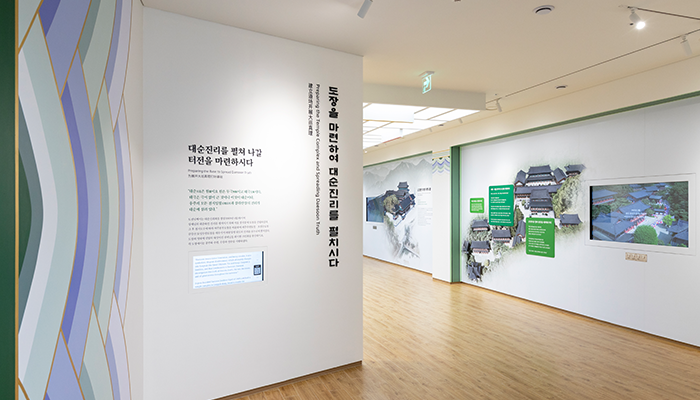
6Preparing the Temple Complexes and Spreading Daesoon Truth

7Illuminating the Path to Unification with the Dao
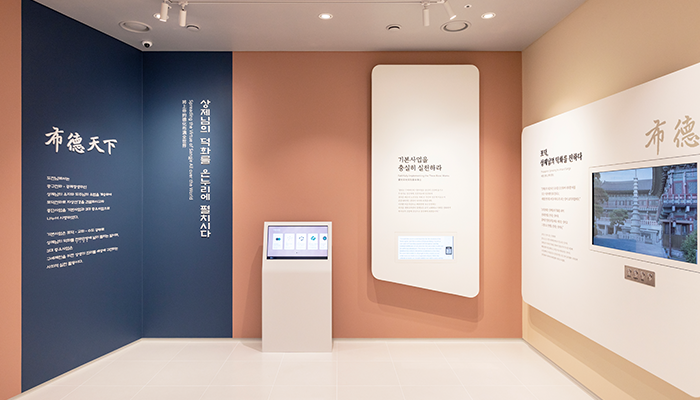
8Spreading the Virtue of Sangje all over the World

9Spreading the Truth of Sangsaeng throughout the World

